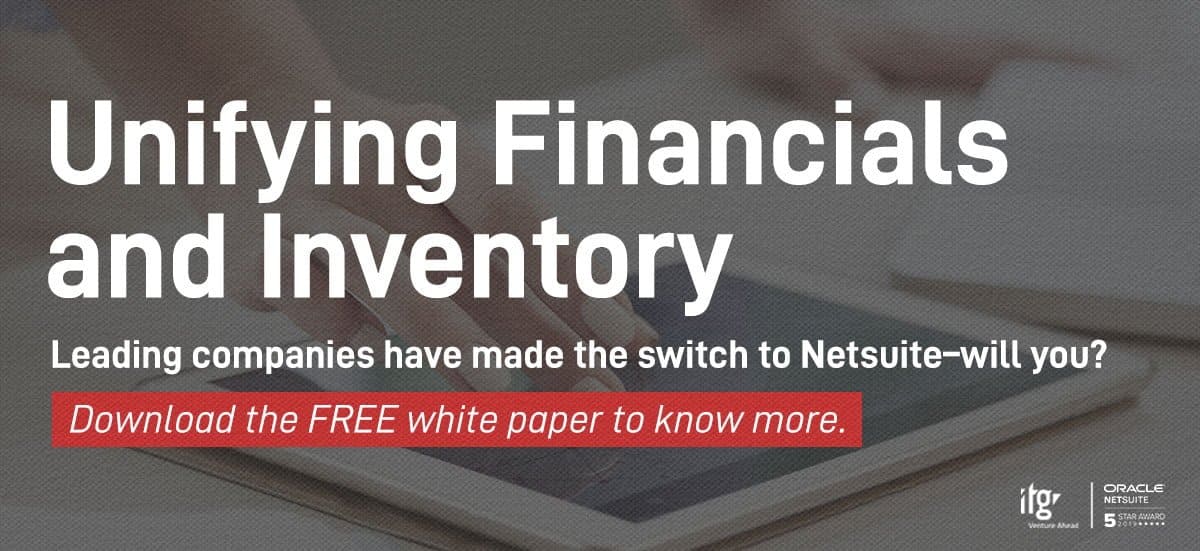
Free White Paper: Unifying Financials and Inventory
We have all heard the phrase “cash is king.” It is the mantra most companies live by. It is also why purchasing an application to manage money is usually the first business software investment companies make.
As a starter, an accounting package is a logical and economical choice. At a high level, it provides the basic functionality any business needs in a financial management system: enabling the management of a company’s chart of accounts, along with a systematic method of managing its relationships with vendors and customers through accounts payable and accounts receivable respectively. Providing this core functionality at a reasonable price point has made the choice of cost-effective accounting systems a norm across many industries.
However, as innovation evolves faster than ever, heightened customer expectations and increased competition mean companies can no longer rely on the business models or business management systems of the past. The reality is that times have changed. The internet has provided a platform upon which to build entirely new business models. Inefficiencies and wasted time on routine tasks, such as the monthly close, are no longer accepted. Business decisions are now driven by key performance data, not historical practices or best guesses. Real-time visibility and insight can now be the difference between thriving and barely surviving.
Netsuite: A Suite Approach
NetSuite believes in the power of a unified suite of applications that spans the whole of the business, linking key business processes together on the same platform. A suite approach allows the whole company to view operations as a single version of the truth. Furthermore, predefined roles and dashboards that are oriented around a user’s day-to-day tasks allow for the most efficient consumption of information throughout the entire organisation.
Having inventory and financial data on the same platform provides companies with a competitive edge with the ability to plan effectively, execute predictably with customers and minimise labour costs and errors associated with manual reconciliation.
The Benefits of a Cloud Solution
In addition to our suite approach, NetSuite is a true cloud platform. It is important for companies to understand that a cloud-based vendor doesn’t just offer software, but also a service. This means that NetSuite takes responsibility for not only the software it supplies, but the underlying technical infrastructure needed to access the solution.
That includes the server hardware and database maintenance and administration, document storage, technical upgrades, and the ongoing enhancements customers need. That is an entirely different way of providing a system than what has been traditionally offered where, for all practical purposes, it is the customer’s responsibility to upkeep their systems on an infrastructure they must initially purchase, but also maintain.
A vendor offering Software-as-a-Service is on the hook for all aspects of that service, which in turn means the vendor must continuously earn the trust of its buyers, backed by meaningful service level agreements. It doesn’t serve a modern cloud provider’s interests to do anything other than assure customer success. That is a win-win in anyone’s book, but again, fundamentally different than the old way of acquiring and using software.
A well-implemented cloud-based system means that financial activities appear as soon as they are triggered. That, coupled with ‘anywhere-anytime’ access means that decision makers can quickly act upon both adverse and favourable performance indicators. In that sense, decision- making becomes an activity where those tasked with executing on the company’s goals and strategy are able to do so with information that is akin to looking through the front windshield of a car, rather than constantly worrying about what is in the rearview mirror.
The combination of these demonstrable benefits means that a well-executed move to cloud results in a much better and predictable cost of operation than is possible with on- premise systems.
ITGCon Baguio 2025: Advancing Regional Innovation with Secure IT and Intelligent Solutions
ITGCon Baguio 2025: Advancing Regional Innovation with Secure IT and Intelligent Solutions July 10, ...
ITGCon Bataan 2025: Powering Progress, Protecting the Future
ITGCon Bataan 2025- Powering Progress, Protecting the Future Banner June 26, 2025 | Balanga, Bataan ...
IT Group Inc. Launches New Managed SOC Powered by CYREBRO to Help Businesses Stay Ahead of Cyber Threats
IT Group Inc. Launches New Managed SOC Powered by CYREBRO to Help Businesses Stay Ahead of Cyber ...



